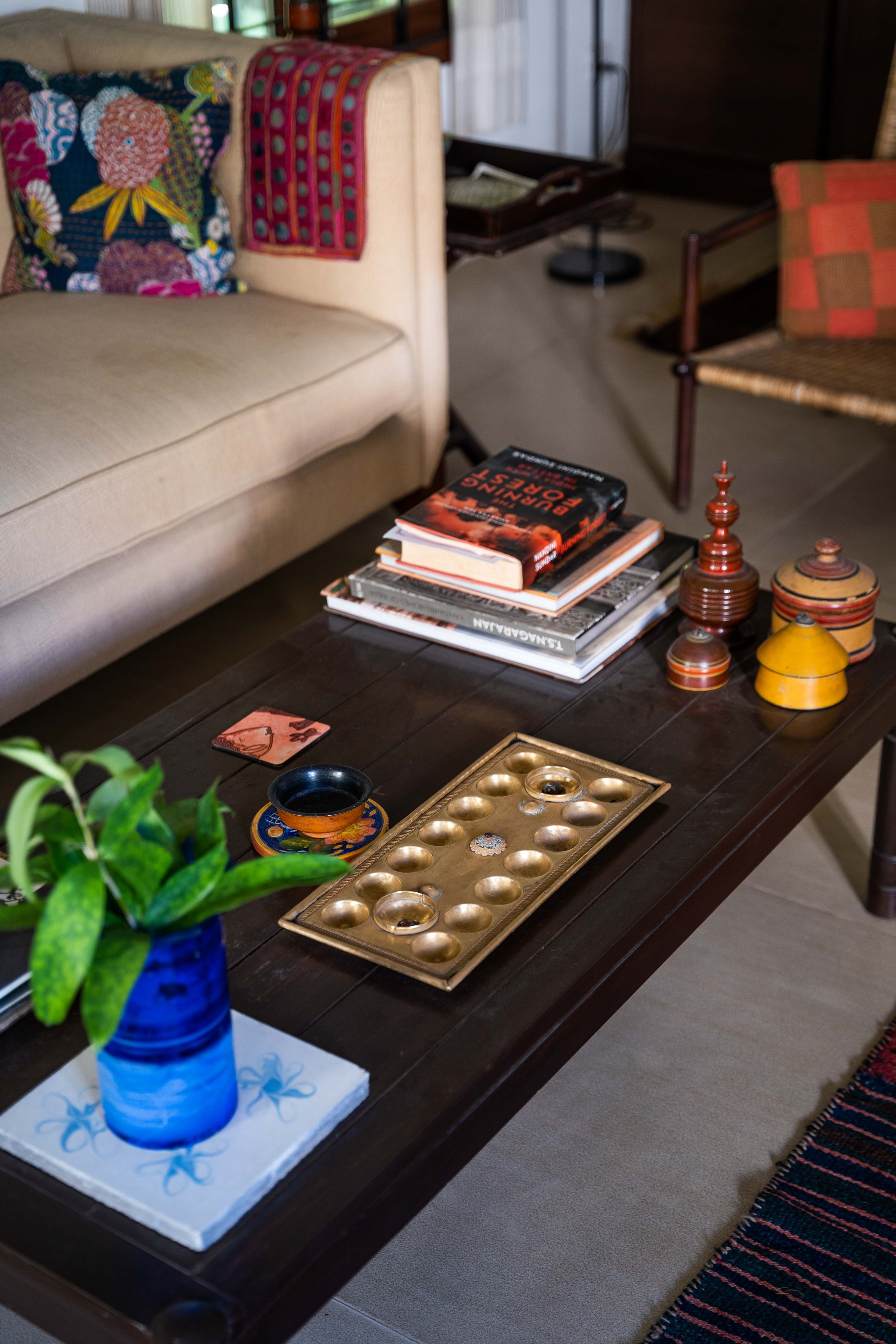A Swing, a Courtyard, and a Surplus of Bookshelves
By Ashna Lulla
Photos by Vignesh Sivakumar
Among neatly lined avenues with three-storey apartments and walls pleading to ‘stick no bills’, Shanta Guhan’s home stands beaming in-between. The Mangalore tiled roof and mustard yellow compound walls are a preamble to the delightfully curated home that unfolds beyond it.
The house was built on the same plot as Shanta’s previous home. As she stepped into her 80s, she couldn’t afford to deal with stairs or a layout that didn’t suit her needs. So she turned to her brother-in-law, Venkat Aiyadurai of Nataraj and Venkat Architects (NVA). In 2013, overnight, her house was demolished. But Venkat assured her that she wouldn’t feel unfamiliar in her new space, ensuring that it still held within its walls the spirit and memory of her previous home. To achieve this, Shantha’s requests were simple: a swing, a surplus of bookshelves, and a courtyard.
The swing was bought several decades ago when her husband and she lived in Thiruvidanthai, a temple town in South Chennai. Stored away for years in between moves, Shanta decided it had to have its moment. The smooth, teak wood surface and the chain of the oonjal perfectly frame an exquisite piece of art that lies just behind it: an impressive, handmade dual-tone piece of Kashmir embroidery.
Shanta has been a resident of the Adyar-Besant Nagar area for nearly 40 years and holds this locality very close to her heart, and this relationship is reciprocated. She tells me that the ‘Guhan house’ is so well known that friends need not worry about errors on a postal address when they write to her. The letter will find its way easily. Everyone knows the Guhan house.
Her attachment to this area is not only due to the proximity to the sea but to Kalakshetra and Dakshinachitra’s city office –– hallmarks in Chennai’s cultural landscape. Shanta was an associate with Rukmini Devi Arundale, Kalakshetra’s founder, and an active member of its textile centres. Her propensity for textiles and handicrafts is reflected in the fabrics found across her home; rustic handwoven dhurries in jewel tones, layered and draped across her furniture that span the warp and weft of India.
Quite modestly, Shanta says she has no technical training in textiles or craft, yet, she’s an aesthete nonpareil –– evidenced by her work with the Craft Council of India; what she’s collected over years in her home, she says, is guided by intuition and influenced by her friends. Wooden figurines of parrots and humans, candle holders and brass sculptures, dotted around the living room tie together a design perspective that is so humble in its magnificence.
Every corner of the house is decorated with books and magazines. Functionally, it’s a necessity to hold the volumes on economics, poetry, and biographies that for the most part belonged to her husband. But it also complements the lazy daybed that is flanked by two bookshelves and catches the sunlight pouring in from the windows; the cane furniture that you can sink into while you peruse Vidya Dehejia’s new release, ‘India: A Story Through 100 Objects’.
A lull in our conversation is disrupted when Shanta calls out: ”Billi! Billi!” –– an unimaginative name for her cat, she admits. “Has Vignesh taken enough pictures of you? Come out and say hi to everyone else.” Billi is unmoved, sitting sleepily on a chair tucked under the dining table. Shanta tells me about the day Billi just walked straight into their old home on this plot, into the kitchen, and made herself a member of the household. Almost as if the move was discussed and agreed upon. Shanta surrendered to her new permanent guest thinking “someone as smart as you, I can’t get rid of.”
It might not seem like it, but there’s something quite revealing about that story. About the allure and warmth that has been created at the Guhan house, from a feline perspective or otherwise. It's not a fussy home. It feels familiar in the way that it is lived in but cared for. Shanta reminisces about the get-togethers she’s hosted for her friends, including the company of Leela Samson and Amartya Sen. She loves having people over and says that everyone feels at home and no one wants to leave in a rush.
When she lived in Delhi and Kolkata, Shanta said she had such a skewed perception of what Chennai, Madras at the time, was; a prejudice that is not uncommon is that it is a slow, boring town of conservative-minded people. After moving here in the 70s, Shanta says there is not a single place she would like to call home over Chennai. Of course, her close ties with the unique exposure to arts and culture that belongs to the city has nurtured this connection. But Shanta’s commentary on building a life in Chennai was well-informed. She remarked that you can choose what you want from all that the city has to offer: a fast-paced, busy routine; a path that is immersed in artistic endeavours; or a quiet life in not much more than your own company. Chennai offers you all and each of these in ways that you are content with whatever you have chosen.
Most of Shanta’s days are now spent enjoying the sea breeze that drifts across her courtyard. Morning tea and the newspaper is consumed in the pleasant ambience of palms and plumeria. By evening time the pockets of shade are a cool break from the day’s happenings within the mustard yellow compound walls.







